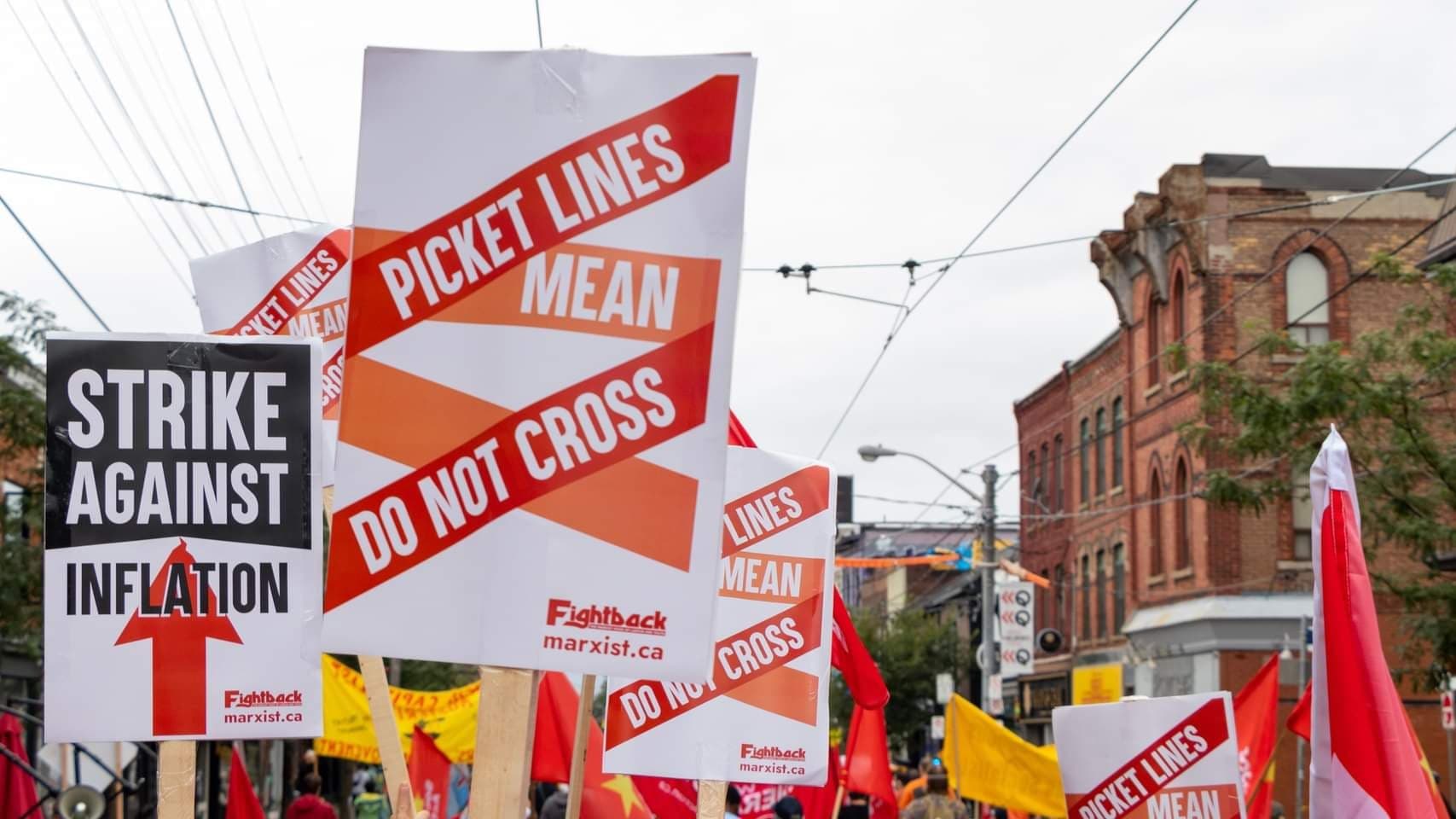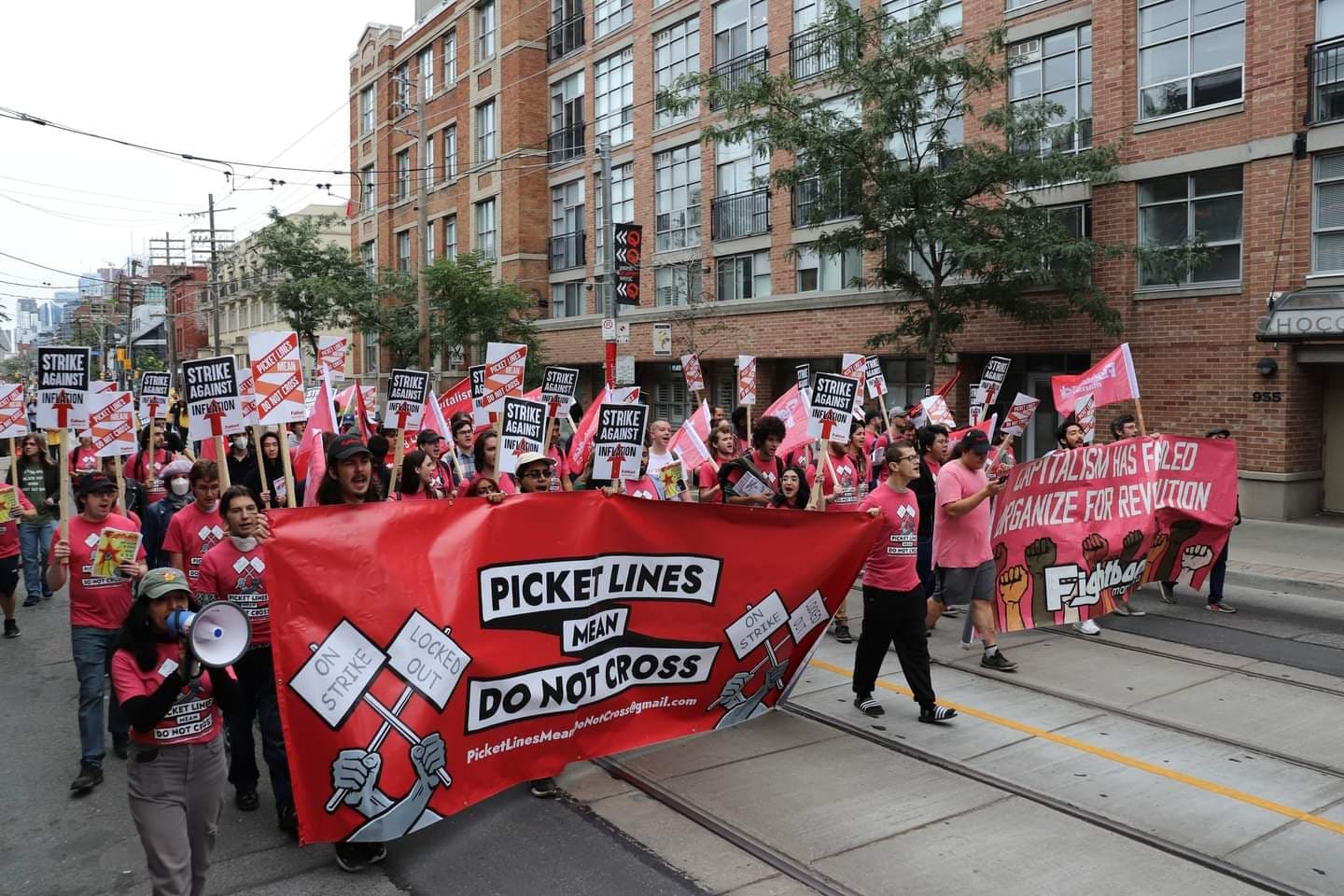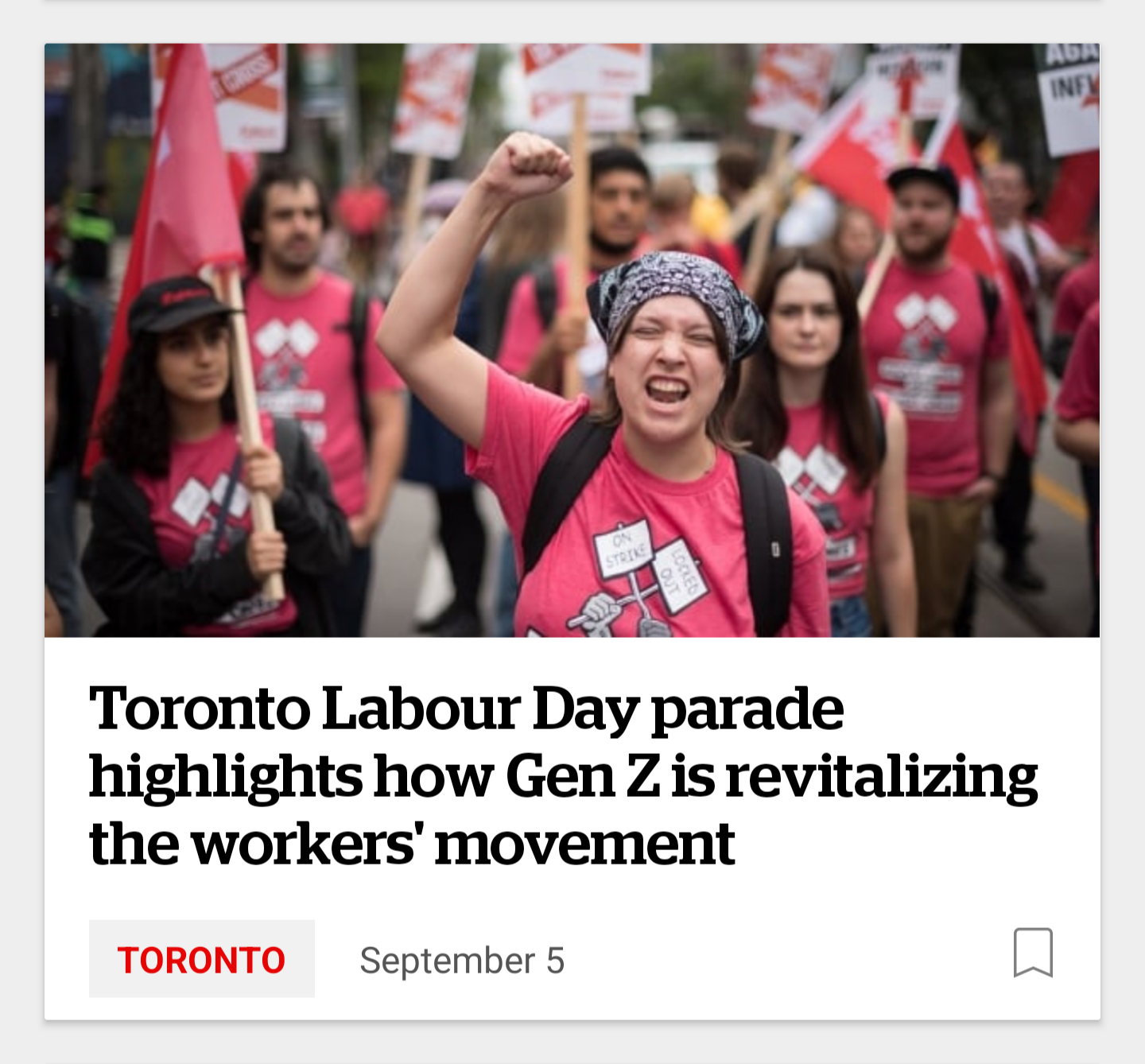
On Monday, Sept. 5, tens of thousands of workers took part in a march in downtown Toronto for Labour Day, the first since the beginning of the pandemic two and a half years ago. With a growing inflation crisis and increased attacks on workers, this was a prime opportunity for the labour movement to mobilize a political show of force. Instead, the Toronto and York Region Labour Council, the main organizers of the event, chose to cross the picket lines of OPSEU 546 safety inspectors and suppress radical young workers who were demanding to defend the lines.
Since July 21, 170 safety inspectors with OPSEU Local 546 TSSA have been forced to strike by a union busting boss. Fightback has attended the picket lines of these workers, and interviewed workers who outlined the disgusting tactics by the TSSA (the boss) which included stonewalling negotiations, using scab labour, and deliberately risking public safety to attack the union. The workers are an essential part of keeping tens of thousands of Ontario fuel stations, apartment buildings, nuclear plants, amusement parks, amongst other things, up to safety standards.
Their work includes the safety standards kept at the Canadian National Exhibition (CNE) where the Labour Day march traditionally ends up with workers attending with their families. Currently, the TSSA is disgustingly using scab labour to replace the work of the safety inspectors, taking food off their families’ table. With thousands of workers coming together on this day in what is the largest parade of the year, it provided a perfect opportunity for the labour movement to bolster the picket lines at the CNE and fight back against this injustice.
Former president of the Ontario Federation of Labour (OFL), Sid Ryan explained the behind the scenes discussions in preparations for the parade which did not bode well for the safety inspectors:
“According to an executive of OPSEU the union brought a request to the Labour Council meeting asking that the “parade” not cross their picket line. Some affiliates pushed back and objected and so OPSEU withdrew the request.”
The Labour Council, fully aware of the strike of the safety inspectors and the use of scabs at the CNE, began sending out bracelets as a free pass to cross the lines of workers. Some labour activists voiced concern over infighting at the leadership level around the CNE lines, but what is the point of union solidarity if you choose to break a picket line of striking workers so some others can go on rides serviced by scab labour?
Some defenders of the Labour Council’s decision argued that “there was no picket line”. But is this the fault of the safety inspectors or the Labour Council, who demanded the removal of pickets so they could walk into the CNE? Some have even made the outlandish argument that “there is no strike because they don’t have a contract yet”. The safety inspectors have run rotating information pickets at the CNE for weeks, including flyers and literature explicitly mentioning that there is a strike, and also, they are a union that is on strike. Even if there was not a picket line, there are scabs at the CNE and it is another basic principle not to support scab labour. The cognitive dissonance implemented by some loyalists to the Labour Council executive is incredible and shows the state of their leadership.
Only OPSEU, UNIFOR, and some smaller locals publicly announced their refusal to cross the picket lines, diverting their contingents at the end of the march. In one example, CUPE Local 905 stated: “CUPE 905 will be marching in the Labour day parade but will not be entering the CNE grounds.” In a show of solidarity with OPSEU Local 546, several CUPE members and members of the Picket Lines Mean Do Not Cross campaign, including those from CUPE 4400, took the flyers of safety inspectors which contained information about the strike and handed them out at the entrance of the CNE.
The USW, CUPW, LIUNA, and many affiliates with thousands of members crossed the lines, even though this does not represent every single member of said unions. Many were surprised and shocked at what was occurring only having found out at the last minute after seeing the flyers. Most workers were simply not aware of the existence of the strike or scab labour, thanks to a lack of information from their local and national leaderships.
If crossing the lines was not bad enough, some Labour Council officials tried to physically remove a contingent of 100+ young workers carrying a banner and t-shirts saying “Picket Lines Mean Do Not Cross”. Most of these youth were under 25 and had been politicized to support union politics during the pandemic. One Labour Council executive grabbed the banner, ripping it from the hands of the marchers, causing injury to one young worker. Feeling the critique from crossing lines, the Labour Council bureaucracy sought to suppress any solidarity with respecting pickets. Thankfully the large radical youth contingent could not be stopped and it continued to march peacefully.
The disgusting nature of this attack was shown by a CBC article about Labour Day that featured the very young workers that the bureaucrats were trying to remove. Titled “Toronto Labour Day parade highlights how Gen Z is revitalizing the workers’ movement”, the article quoted Donovan Ritch, “an organizer with youth labour advocacy group Fightback, [saying] “Workers are sick and tired of being exploited, having to work long hours and being made to do all this extra work and not being paid for it. The younger generation, they don’t know a lot about what unions are and what they can do, but they’re learning that they need to take action in some form.” Ironically, the main image in the article was of the same young workers who only hours earlier had been attacked by the Labour Council executive member.
While some labour leaders are showing their bankruptcy, there was also a brighter indication of the future of the labour movement. Hundreds of thousands of mostly young, non-unionized workers are getting unionized across North America, in Amazon, Starbucks, and traditionally precarious non-unionized workplaces. The 100+ youth activists at Toronto Labour Day are a representation of this growing phenomenon.
This conflict highlights an ongoing issue of the struggle between radical political trade unionism vs. business unionism that attempts to remove real working class politics. Commenting on the state of the parade, Sid Ryan made an impassioned point about the apolitical nature of Toronto Labour Day:
“…it’s a rare occasion when labour can get 30,000 workers out on the streets so please do not send thousands of workers the wrong message by suggesting that when it’s inconvenient or a freebie is available it’s ok to cross a picket line. Think of the personal sacrifices these members of OPSEU are making. How many of them are struggling to keep their heads above water, how many will lose their homes, their marriage, their kids having to forego university or some other dreadful scenario. For God sake do not give the TSSA bastards a moral victory by having tens of thousands of union members cross OPSEU local 546 picket lines. Let’s make this 150th Anniversary of the TYDLC a memorable teaching moment and show the TSSA what the word Solidarity actually means.”
Other seasoned trade unionists in the labour movement commented on Ryan’s posts and in other circles. Many have voiced their outrage at this state of affairs and denounced the Labour Council crossing the lines.
Recently, the Picket Lines Mean Do Not Cross education campaign was created by dozens of unionized and non-unionized workers across Canada for the very purpose of highlighting the importance of the labour movement respecting picket lines. It also advocates for labour’s militant tactics of the past which is desperately needed to solve the crisis that working class people face on a daily basis.

Adding to the scandal was the welcoming of the political enemies of working class people. After spending most of his term attacking the homeless population brutally through the police, cutting taxes for the rich, and instituting austerity against city workers,Toronto Mayor John Tory was invited to attend the Labour Day Parade and with a big smile took pictures with union leaders. Reminiscent of former Unifor president Jerry Dias having photo ops with Doug Ford, leaders like current Unifor President Lana Payne stood side by side with the mayor and former Ontario PC leader.
Clearly, there is a crisis of leadership in our labour movement. There is little to no respect for picket lines by the tops of the labour leaderships and this parade was a crystal clear example of that. There is hardly any militant action against scabs. Labour needs to fight to achieve what it wants. We need to reject apolitical trade unionism that places freebies like free tickets to the CNE above respecting a picket line. Instead we need to mobilize thousands over class struggle issues like fighting for wages above inflation, equal pay for work of equal value, social housing, and free education and childcare. The labour movement needs a leadership that will embrace radical young workers as the future of the movement, rather than kicking them to the back of the line. We need a leadership that fights back.


